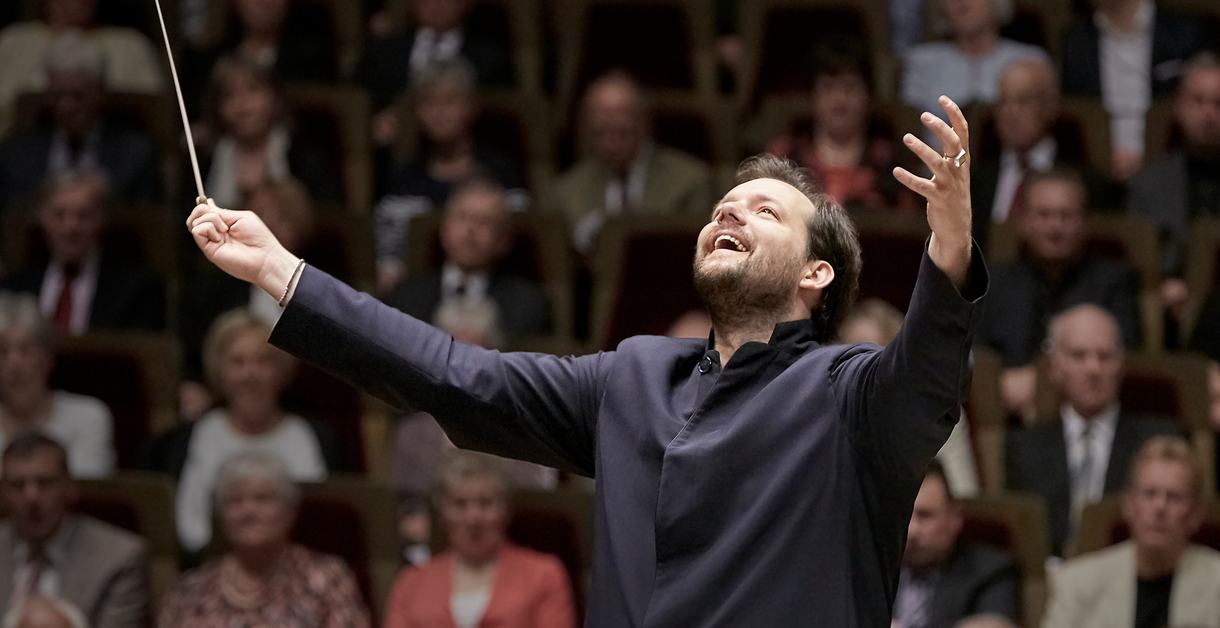 |
| Andris Nelsons : Photo Jens Gerber 2017 |
Andris Nelsons conducted the Leipzig Gewandhaus Orchestra (Gewandhausorchester Leipzig) in Mahler Symphony no 5 and Bernd Alois Zimmermann Nobody Knows de Trouble I've seen with Håkan Hardenberger, at the Royal Festival Hall in the first of two concerts marking the start of a five year assocaition between the Leipzig Gewandhaus Orchestra and the South Bank. The Gewandhausorchester are regular visitors to London (I first heard them with Kurt Masur) but wow, were they sounding good tonight. The dynamic between players and conductor was like electricity - nothing wasted, quick and agile. The tiniest flick of Nelson's fingers and the Leipzigers knew exactly what to do. No messing about, no fluffed cues ! This is a virtuoso orchestra, yet so full of life and expression, and with Nelsons, there seems to be a real spark.
Nelsons has of course conducted this symphony many times, but one of the many things I liked about this particular performance was the way he seemed to be building on the strengths of this orchestra and its unique heritage. It made me reflect on how the Mendelssohn DNA in this orchestra creates the Leipzig sound - warm, dignified and extremely humane. This is pertinent applied to Mahler because his music, far from being bombastic or hysterical, reveals itself best when approached with sensitivity. Although this symphony requires a large orchestra, it operates like chamber music, where individuals pay attention to the others and every note, no matter how small, cointributes to the whole. In some ways, Mahler 5 works like a string orchestra writ large, brass and winds extending instrumental colour. Trumpets lead, but the soul resides in the murmuring "heartbeats", the lower-voiced strings which here seemed to pulsate like a living organism. The celli were placed in the centre, violins and violas around them, basses behind, the winds mediating between the strings, brass and percussion. This symphony connects to Kindertotenlieder, a song cycle with quasi-symphonic structure. There are also connections to Um Mitternacht , another Rückert setting, completed a fe3w months later. "Um Mitternacht/Nahm ich in Acht/ Die Schläge meines Herzens." Paying attention to something barely perceptible in the course of daytime bustle, but heard most clearly in the stillness of night. And note the final verse "Herr über Tod und Leben/Du hältst die Wacht/Um Mitternacht! " Life is fragile, dependent on the beating of a small(ish) organ in the body. It is also significant that the symphony was written not long after Mahler had had a near brush with death in 1901, when the symphony was in gestation. All this is absolutely relevant to interpretation, and thus to performance.
What I liked about Nelsons and the Gewandhausorchester Leipzig's Mahler 5 was thus intimacy. The symphony can be done as Big Blast Phil Spector Wall of Sound, which is of course exciting. But for me, anyway, real excitement comes from understanding how the climaxes grow from the quiet moments where the focus is on tiny details, like the ping of the triangle, which on this occasion was every bit as powerful n its own way as the more obviously dramatic trumpet introduction, also beautifully played, echoed later by the other trumpets. Collegiality matters in Mahler 5. Like the human body, the music lives when its components work together. And chamber music collegiality comes naturally to an orchestra like the Gewandhausorchester Liepzig. At moments I felt I could hear the sound of individual players and instruments, working together rather than absorbed into undifferentiated mass. If a symphony should contain the world as Mahler said, this is what it might sound like. Much more hunman and personal ! In this increasingly polarized world, the last thing we need is Party Rally "excitement" in music.
Like the beating of a heart, the Trauermarsch was neither hyper nor feeble, but steady and unostentatious. A funeral march, but disciplined, as one might hear in the kind of military garrison town such as Mahler grew up in. Not a flashy militarist procession ! Very deliberate, not long enoughtoi break the flow but just enough to catch the breath - Um Mitternacht Hab' ich gedacht hinaus in dunkle Schranken. This emphasized the contrast with the Stürmisch bewegt section which followed, showing them as two connected parts of the same whole. A lively Scherzo and then one of the most beautiful Adagiettos in a long time, so lovely that it was perhaps the highpoint of the evening. The harps sparkled, the strings shimmered : truly a hymn to love, though not just in the sense of a Valentine for Alma as this section is sometimes marketed. The love here is more transcendent : the love of life itself, a theme that flows through so much of Mahler's music like lifeblood, pumping through the heart. The warmth and assurance that the Leipzigers do so well enriched this performance. Yet again, consider the way Um Mitternacht concludes on a high, with a kind of mini-anthem. Thus the Rondo Finale which pulls together the dfferent threads of the symphony, creating a sense of purposeful unity. In short, the Gewandhausorchester Leipzig trademark style, unfussy but profound.
Nelsons has conducted Bernd Alois Zimmernann's Nobody Knows de Trouble I've Seen paired with Mahler 5 with the Berliner Philharmoniker since it features a stunning, jazzy trumpet part (Håkan Hardberger, too) as does the symphony. But the glow of the Gewandhausorchester Leipzig is different from the shine of the Berliner Philharmoniker so this time, the combination didn't work as well.


.jpg)











